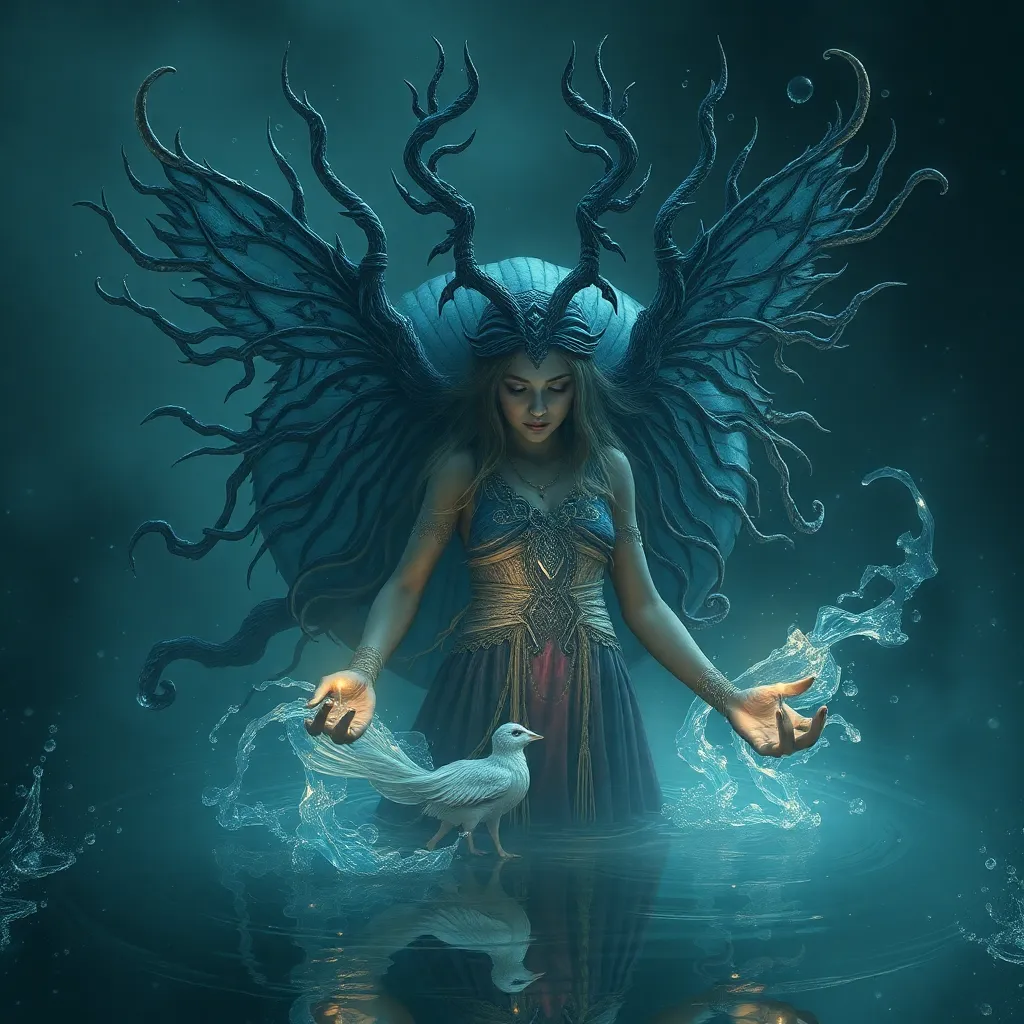Rusalka as Harbinger: Exploring the Roles of Water Spirits in Slavic Folklore
I. Introduction
Slavic folklore is a rich tapestry woven with tales of gods, spirits, and mythical creatures. It holds significant cultural importance, reflecting the values, beliefs, and customs of Slavic peoples throughout history. Among these enchanting figures are water spirits, entities that embody the duality of water as both life-giving and perilous.
At the forefront of these water spirits is the Rusalka, a captivating yet tragic figure that represents the complex relationship humans have with nature, especially water. This article delves into the nature of Rusalka, her symbolism, and her role as a harbinger in Slavic mythology.
II. The Nature of Rusalka
A. Definition and characteristics of Rusalka
A Rusalka is often depicted as a beautiful young woman with long hair, sometimes adorned with flowers or aquatic elements. Traditionally, she is associated with water bodies such as rivers, lakes, and ponds. Her nature is both alluring and dangerous—she can enchant men with her beauty but may also lead them to their doom.
B. Historical origins and evolution of the Rusalka figure
The origins of the Rusalka can be traced back to ancient Slavic beliefs about water and fertility. Initially seen as benevolent beings, Rusalki were thought to be the spirits of young women who died tragically, often by drowning or as a result of unfulfilled love. Over time, their image evolved, and they became more associated with mischief, vengeance, and the darker sides of love and desire.
C. Variations of Rusalka across different Slavic cultures
While the core concept of Rusalka remains consistent, variations exist across different Slavic cultures:
- Russian Rusalka: Often portrayed as a spirit that lures men to watery graves, embodying both beauty and danger.
- Ukrainian Rusalka: Celebrated during the Rusalka Week, a traditional holiday honoring the spirits of the drowned.
- Polish Rusalka: Similar to the Russian version but with distinct folklore elements that emphasize her connection to nature.
III. Symbolism of Water in Slavic Mythology
A. The dual nature of water: life and death
Water serves as a key symbol in Slavic mythology, representing both life and death. It is essential for agriculture, sustenance, and fertility, yet it also has the power to take lives. This duality is embodied in the figure of Rusalka, who exists at the intersection of these two forces.
B. Water as a source of fertility and renewal
In Slavic tradition, water is often associated with fertility. Rivers and lakes are seen as sources of life, renewing the earth and sustaining crops. Rituals involving water are common during spring and summer, highlighting the importance of this element in agricultural practices.
C. Water as a boundary between the living and the spirit world
Water is also viewed as a threshold between the living and the supernatural realms. It is believed that spirits, including Rusalki, inhabit these watery domains, making them both sacred and feared. This boundary blurs during certain times, such as the summer solstice, when the veil between worlds is thought to be thinnest.
IV. Rusalka’s Role as a Harbinger
A. Rusalka as a messenger of change and transformation
Rusalka embodies change, often appearing during significant seasonal transitions. She is seen as a harbinger of summer, signifying the arrival of warmth, growth, and vitality. Her presence is a reminder of the cyclical nature of life and death.
B. The association of Rusalka with seasonal cycles and agricultural practices
In many agricultural societies, Rusalki are linked to the fertility of the land. Rituals performed in her honor were believed to ensure a bountiful harvest. Farmers would often seek her blessing for rain and prosperous crops, reinforcing her role as a protector of nature.
C. Rusalka’s connection to human emotions, particularly love and despair
Rusalka also symbolizes the complexities of human emotions, particularly love and despair. Her tragic backstory—often involving unrequited love or betrayal—resonates with themes of longing and loss. This emotional depth makes her a powerful figure in folklore.
V. Comparative Analysis: Rusalka and Other Water Spirits
A. Similarities and differences with other Slavic water spirits (e.g., Vodianoi, Nixie)
Rusalka shares characteristics with other Slavic water spirits, such as the Vodianoi and Nixie. However, while Vodianoi are typically male and embody a more aggressive nature, Rusalki are female and often represent beauty and tragedy. This gender dynamic is significant in understanding their roles in mythology.
B. The role of female water spirits in other cultures’ mythologies
Many cultures feature female water spirits, such as:
- Mermaids: In Western folklore, mermaids are often portrayed as beautiful but dangerous.
- Yemaya: In Afro-Caribbean traditions, Yemaya is a mother goddess associated with the sea.
- La Llorona: In Latin American folklore, La Llorona is a spirit mourning her lost children, often associated with water.
C. Cross-cultural influences and adaptations of water spirit legends
The legends of water spirits, including Rusalka, have influenced and adapted across cultures. This cross-pollination illustrates the universal themes of water as a source of life, transformation, and the supernatural.
VI. Rusalka in Modern Adaptations
A. Representation of Rusalka in literature and art
Rusalka has inspired countless works of literature and art. From Pushkin’s poem “Rusalka” to Dvořák’s opera “Rusalka,” she remains a potent symbol of beauty and tragedy. Artists often depict her as a figure of sorrow, reflecting the pain of lost love.
B. The impact of Rusalka on contemporary media (film, music, etc.)
In modern media, Rusalka’s character has been explored in films and music, often reinterpreting her story to resonate with contemporary audiences. This has led to a resurgence of interest in Slavic folklore and its themes.
C. The role of Rusalka in modern Slavic identity and cultural revival
As Slavic nations seek to reclaim their cultural heritage, Rusalka serves as a symbol of national identity. She embodies the connection to nature, tradition, and the spiritual world, revitalizing interest in Slavic mythology.
VII. The Psychological and Cultural Significance of Rusalka
A. Rusalka as a symbol of feminine power and tragedy
Rusalka represents feminine power, embodying both allure and danger. Her tragic fate invites discussions about women’s roles in society and the consequences of unfulfilled desires.
B. Exploration of themes of loss, longing, and the supernatural
The themes surrounding Rusalka delve into the human experience—loss, longing, and the quest for understanding the supernatural. These themes resonate deeply in contemporary society, reflecting the complexities of human emotions.
C. The relevance of Rusalka in contemporary discussions of environmentalism and water rights
In an age of environmental awareness, Rusalka’s story takes on new significance. As a water spirit, she symbolizes the need to protect natural resources and advocate for water rights, highlighting the connection between mythology and contemporary issues.
VIII. Conclusion
Rusalka’s multifaceted roles in Slavic folklore reveal much about the cultural narratives surrounding water spirits. From her origins as a tragic figure to her modern adaptations, Rusalka continues to captivate audiences. The enduring legacy of water spirits like Rusalka invites further exploration and appreciation of Slavic mythology and its relevance in today’s world.



